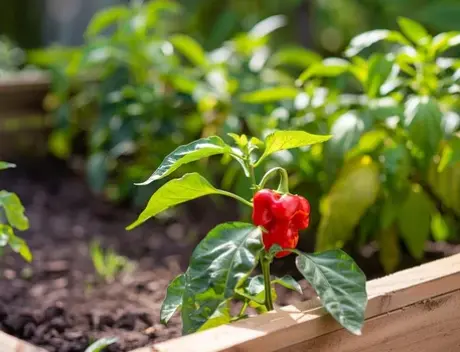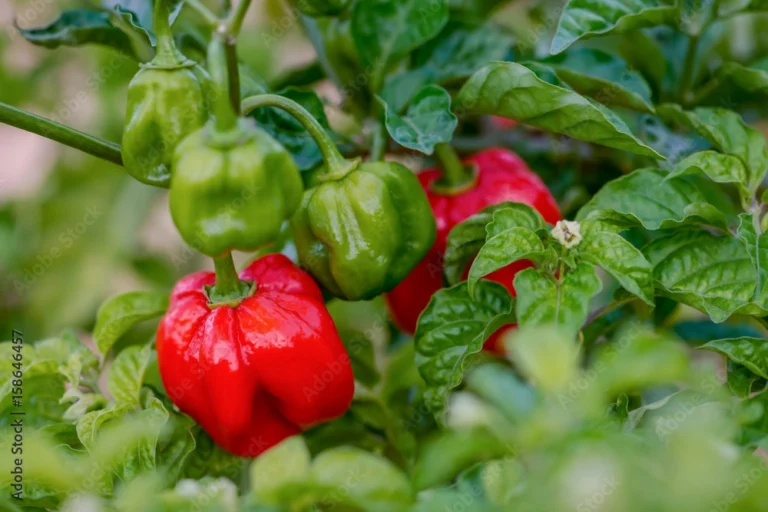Carolina Reaper Seeds: World’s Hottest Pepper
Growing and cultivating Carolina Reaper seeds is a rewarding experience for chili enthusiasts who appreciate the intense heat and unique flavor of this notorious pepper. The Carolina Reaper, currently recognized as one of the hottest peppers in the world as compared to other peppers or substitutes, requires specific growing conditions and care to thrive. This comprehensive guide will walk you through the entire process, from planting and nurturing the seeds to harvesting the fiery fruits.

Introduction
The Carolina Reaper is not just any pepper; it’s a challenge for even the most seasoned chili growers. Developed by Ed Currie of the PuckerButt Pepper Company in South Carolina, this pepper holds the Guinness World Record for the hottest chili, with an average Scoville Heat Unit (SHU) of 1.64 million, and peaks that exceed 2.2 million SHU. To grow this pepper successfully, you must start with high-quality Carolina Reaper seeds and follow specific guidelines to ensure a successful harvest.
How to Grow Carolina Reaper Pepper
Choosing and Preparing Carolina Reaper Seeds
When selecting Carolina Reaper seeds purchasing them from a reputable source is crucial is crucial. Authentic Carolina Reaper seeds should be from a trusted supplier to guarantee that you are growing the true variety. These seeds are typically available online through specialty seed companies or directly from the PuckerButt Pepper Company.

Seed Preparation:
Soaking the Seeds:
Some growers recommend soaking Carolina Reaper seeds in warm water or a diluted hydrogen peroxide solution for 12-24 hours before planting. This process can help soften the seed coat, promoting faster germination.
Germination Setup:
Use a high-quality seed-starting mix, which is light, well-draining, and rich in nutrients. Fill small pots or seed trays with the mix, ensuring moist but not waterlogged.
Germinating Carolina Reaper Seeds
Germinating Carolina Reaper seeds can be a bit tricky, as they require consistent warmth and moisture to sprout. The process can take anywhere from 7 to 21 days, sometimes even longer, depending on the growing conditions.

Optimal Conditions for Germination:
Temperature:
Maintain a consistent temperature between 80°F to 90°F (27°C to 32°C). Using a seedling heat mat can help achieve and maintain this temperature range, which is critical for successful germination.
Light:
While light isn’t necessary for the seeds to germinate, placing the seed tray in a warm, bright area once they sprout will encourage healthy growth. A grow light can be beneficial if natural light is insufficient.
Humidity:
Keep the soil moist but avoid overwatering. Covering the seed tray with a plastic dome or plastic wrap can help retain humidity, which is crucial for germination.
Transplanting Carolina Reaper Seeds
Once the seedlings have developed two to three sets of true leaves, they are ready to be transplanted into larger pots or directly into the garden, depending on the climate.


Transplanting Tips:
Hardening Off:
Before transplanting, it’s essential to harden off the seedlings. This process involves gradually exposing them to outdoor conditions over a week. Start by placing them outside for a few hours each day, gradually increasing the time and intensity of sunlight they receive.
Soil Preparation:
Carolina Reapers seeds thrive in well-draining, nutrient-rich soil with a slightly acidic pH of 6.0 to 6.5. Before planting, amend the soil with organic matter like compost or well-rotted manure to provide essential nutrients.
Spacing:
Space the plants 18 to 24 inches apart to allow for proper air circulation and to give each plant enough room to grow. Crowding can lead to issues with disease and pests.
Caring for Carolina Reaper Plants
Caring for your Carolina Reaper plants is critical to ensuring a successful harvest. These peppers need consistent attention to thrive, especially during the growing season.
Watering:
- Consistent Moisture: Carolina Reapers seeds require regular watering, but it’s important not to overwater them. The soil should be kept consistently moist, especially during flowering and fruiting, but it should never be soggy. Overwatering can lead to root rot and other fungal diseases.
- Mulching: Applying a layer of mulch around the base of the plants can help retain soil moisture, reduce weed growth, and regulate soil temperature.
Fertilizing:
- Balanced Nutrients: Start feeding your Carolina Reaper plants with a balanced fertilizer once they are established. A fertilizer with equal parts nitrogen, phosphorus, and potassium is ideal. As the plants begin to flower, switch to a fertilizer higher in potassium to encourage fruit development.
- Feeding Schedule: Fertilize every 2 to 4 weeks throughout the growing season, but be careful not to over-fertilize, as this can lead to excessive leaf growth at the expense of fruit production.
Pruning and Staking:
- Pruning: Pruning is not always necessary, but it can help manage plant size and improve air circulation. Remove any dead or diseased leaves and thin out some of the inner foliage to prevent overcrowding.
- Staking: Given the weight of the fruits and the potential height of the plants, staking or using a cage can help support the plants and prevent them from toppling over, especially in windy conditions.
Pests and Diseases
Carolina Reaper plants, like other pepper varieties, can be susceptible to pests and diseases. Early detection and management are crucial for maintaining healthy plants.
Common Pests:
- Aphids: These small, sap-sucking insects can weaken plants and spread diseases. Control them by spraying the plants with water or using insecticidal soap.
- Spider Mites: These tiny pests can cause leaves to become speckled and discolored. Neem oil or miticides can be effective in controlling spider mites.
- Whiteflies: These pests can be controlled with yellow sticky traps or insecticidal soap.
Common Diseases:
- Blossom End Rot: This condition is caused by calcium deficiency, often due to inconsistent watering. To prevent it, maintain consistent soil moisture and consider adding a calcium supplement to the soil.
- Powdery Mildew: This fungal disease can be managed by ensuring good air circulation, avoiding overhead watering, and using fungicidal sprays if necessary.
- Bacterial Spot: To prevent bacterial spots, practice crop rotation, avoid working with wet plants, and remove any infected plant material promptly.
Harvesting Carolina Reaper Peppers
Harvesting is the most exciting part of growing Carolina Reapers. Knowing when and how to harvest these peppers is key to enjoying their full heat and flavor.


When to Harvest: Carolina Reaper seeds
- Color Change: Carolina Reaper peppers are ready to harvest when they turn from green to their signature bright red. The peppers should be fully ripe to achieve the maximum heat and flavor.
- Timing: Depending on the growing conditions, it typically takes 90 to 120 days from transplanting for the peppers to be ready for harvest.
Harvesting Tips:
- Use Pruning Shears: When harvesting, use sharp pruning shears or scissors to cut the peppers from the plant, leaving a small portion of the stem attached. This method helps prevent damage to the plant and encourages further fruit production.
- Handle with Care: Wear gloves when handling the peppers, as the capsaicin that makes them so hot can cause skin irritation.
Post-Harvest Handling and Storage
Once harvested, there are several ways to handle and store Carolina Reapers, depending on how you plan to use them.
Fresh Use:
- Immediate Consumption: Freshly harvested Carolina Reapers can be used in various recipes, from hot sauces to salsas. If you plan to use them fresh, store them in the refrigerator, where they will be kept for up to two weeks.
Drying:
- Air Drying: One of the most common ways to preserve Carolina Reapers is by drying them. Air drying in a warm, well-ventilated area is effective, especially in arid climates. You can also use a food dehydrator for quicker results.
- Grinding: Once dried, the peppers can be ground into a fine powder to use as a spice. Store the powder in an airtight container away from light and heat to maintain its potency.
Freezing:
- Long-Term Storage: Freezing is another excellent method for preserving the peppers. Wash and dry them thoroughly before freezing them in a single layer on a baking sheet. Once frozen, transfer the peppers to a freezer-safe bag or container. Frozen peppers will maintain their heat and flavor for several months.
Making Hot Sauce:
- Homemade Hot Sauce: Many chili enthusiasts enjoy making homemade hot sauce from their harvest. The process typically involves blending the peppers with vinegar, salt, and other spices. Fermentation is an option for those who want to develop a deeper flavor.
Challenges in Growing Carolina Reaper Seeds
Growing Carolina Reaper seeds comes with its set of challenges, but with careful attention and patience, these can be overcome.
Germination Issues:
- Slow Germination: Carolina Reaper seeds can be slow to germinate. Ensuring consistent warmth and moisture is crucial, but it’s also important to be patient, as some seeds may take several weeks to sprout.
Heat Sensitivity:
- Handling the Heat: The extreme heat of the Carolina Reaper means that you must take care when handling the plants and fruits. Always wash your hands thoroughly after handling the peppers, and avoid touching your face or eyes.
Environmental Challenges:
- Climate Sensitivity: These peppers prefer hot, humid climates, which can be a challenge in cooler or drier regions. Growing them indoors or in a greenhouse can help replicate the ideal conditions, but it requires careful monitoring of temperature and humidity.
The Rewards of Growing Carolina Reaper Seeds
Despite the challenges, growing Carolina Reaper seeds is incredibly rewarding. The satisfaction of harvesting and enjoying the fruits of your labor, especially when it’s something as unique and powerful as the Carolina Reaper, is unparalleled for chili enthusiasts. The experience not only offers a deep connection to the plant but also provides an opportunity to explore new culinary adventures.
Using Your Carolina Reapers
Once you’ve successfully grown and harvested your Carolina Reapers, the possibilities for using them in your kitchen are endless. Whether you’re a fan of making your own hot sauces, adding intense heat to dishes, or simply enjoying the thrill of consuming one of the hottest peppers in the world, Carolina Reapers are incredibly versatile.
Hot Sauces and Condiments:
- DIY Hot Sauce: Carolina Reapers are the perfect base for homemade hot sauce. Their intense heat pairs well with vinegar, garlic, onions, and various spices to create a sauce that can be as simple or complex as you like.
- Pepper Mash: Fermenting the peppers into a mash can create a flavorful and spicy base for sauces, marinades, and other condiments. The fermentation process adds depth to the flavor, balancing the heat with a tangy, umami-rich profile.
Cooking with Carolina Reapers:
- Spicy Dishes: Use your Carolina Reapers sparingly in dishes like chili, curries, and stews. A little goes a long way, so it’s best to start with a small amount and adjust to taste.
- Infused Oils and Vinegar: Infuse oils or vinegar with Carolina Reapers for a flavorful kick. These infusions can be used to drizzle over pizzas, salads, or grilled meats for an extra layer of heat.
- Spicy Salsas: Fresh Carolina Reapers can be chopped and added to salsas for a fiery twist. Combine them with tomatoes, onions, cilantro, and lime juice for a salsa that packs a punch.
Sharing and Selling Carolina Reaper Seeds
For those with a successful harvest, saving and sharing Carolina Reaper seeds can be a rewarding way to connect with other chili enthusiasts. Saving seeds from your best plants allows you to continue growing Carolina Reapers year after year, selecting the best traits such as heat, flavor, and disease resistance.
Seed Saving Tips:
- Select the Best Fruits: Choose the healthiest and most robust peppers from your harvest to save seeds from. The seeds from these peppers are more likely to produce strong, healthy plants in the next growing season.
- Drying Seeds: After removing the seeds from the peppers, allow them to air dry on a paper towel for several days. Ensure the seeds are completely dry before storing them to prevent mold and rot.
- Storage: Store the dried seeds in a cool, dark place in an airtight container. Properly stored seeds can remain viable for several years.
Sharing Seeds:
- Gifting: Carolina Reaper seeds make great gifts for fellow gardeners and chili enthusiasts. You can package them in small envelopes with growing instructions for a personal touch.
- Selling: If you’ve grown a large crop, consider selling your seeds online or at local farmers’ markets. Make sure to label them accurately and provide information about the growing conditions and care needed for successful cultivation.
The Future of Carolina Reapers
As the Carolina Reaper continues to hold its title as one of the hottest peppers in the world, interest in growing these peppers from seeds shows no sign of waning. Whether you’re growing them for the challenge, the thrill, or the culinary possibilities, Carolina Reaper seeds represent a unique and exciting aspect of gardening.
Some Queries and Answers
Can you grow Carolina Reapers from seed?
Yes, you can grow Carolina Reapers from seed. With the right conditions, including warm temperatures, consistent moisture, and plenty of sunlight, these seeds will germinate and produce the world’s hottest pepper.
Are Carolina Reapers hard to grow?
Carolina Reapers seeds can be challenging to grow due to their specific needs. They require a warm climate, proper soil, and consistent care, especially during the germination and early growth stages. However, with patience and attention, they can be successfully cultivated.
How spicy is a Carolina Reaper seed?
The Carolina Reaper seeds itself is not particularly spicy, as capsaicin, the compound responsible for heat, is concentrated in the pepper’s flesh and placenta (the white membrane inside the pepper). However, the pepper produced from the seed will be extremely spicy, with a Scoville rating of over 1.5 million units.
How long do Carolina Reaper plants live?
Carolina Reaper plants are perennial in warm climates and can live for several years if protected from frost. In colder climates, they are typically grown as annuals, but they can be brought indoors during winter to extend their lifespan.
Are Carolina Reapers still hot when green?
Yes, Carolina Reapers are still hot when green, but they may not be as intensely spicy or flavorful as when fully ripe and red. The heat and flavor develop more fully as the pepper matures.
Conclusion
Cultivating Carolina Reaper seeds is a deeply rewarding and challenging experience, especially for those passionate about growing peppers. These seeds are renowned for producing the hottest pepper in the world, making them a sought-after choice among chili enthusiasts who crave extreme heat and unique flavors. Carolina Reaper seeds require careful attention to detail, from the moment you plant them through the entire growth process, all the way to harvest. Each stage of growing Carolina Reaper seeds demands precision and care, ensuring that the plants receive the right conditions to thrive. The Carolina Reaper is not just any pepper; it represents the pinnacle of heat and flavor in the chili world, making Carolina Reaper seeds a must-have for serious gardeners and spice lovers. With dedication and the right approach, growing Carolina Reaper seeds can result in an extraordinary and fiery harvest that truly stands out among other peppers.
When you grow Carolina Reaper seeds, you are embarking on a journey that demands patience, consistency, and a genuine love for gardening. These seeds require specific conditions to thrive, such as warm temperatures, ample sunlight, and well-drained soil. With the right care, you can expect your Carolina Reaper seeds to produce plants that yield fiery, red peppers with a heat level that surpasses most other chili varieties.
Compared to other popular peppers like Scotch Bonnet Pepper, Habanero Pepper, and Tabasco Pepper, the Carolina Reaper stands out not only for its heat but also for its unique flavor profile. The intense, fruity taste of the Carolina Reaper adds depth to dishes, making it a versatile ingredient in the kitchen. However, the extreme heat means that this pepper should be used sparingly and with caution.
The process of growing Carolina Reaper seeds also involves handling the plants and fruits with care. Given the high capsaicin content, it’s essential to wear gloves and avoid direct contact with the eyes and skin when working with these peppers. Harvesting Carolina Reapers is a moment of triumph, as the fruits of your labor represent not just a successful gardening endeavor but also a contribution to the rich diversity of chili peppers.



